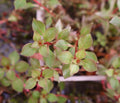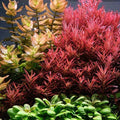6 Aquarium Plants that Don't Need Substrate
There are many aquarium plants that can thrive without substrate, which can be beneficial for those who want to keep a low-maintenance tank or who have fish that like to dig in the substrate. Here are 6 aquarium plants that don't need substrate:
Anubias
Anubias is a rhizome plant, therefore, it doesn't require a substrate and has a rhizome of its own. This plant can grow attached to rocks, driftwood, or other decorations. It prefers low to medium light and doesn't need any fertilizer. The roots cannot be buried because they would decay even in the presence of a substrate. Their long, white roots, which will spread out in quest of nutrition, and the leaves are where they obtain the majority of their nutrients. This plant is quite robust and excellent for beginners. It was one of my very first aquarium plants, and I had a really difficult time killing it. You simply need to be aware that they can't handle excessive illumination because it would cause algae to appear on their leaves. The biggest threat to this plant is algae, so you must always keep it under control.
Java Fern
Java fern is a rhizome; hence, it is extremely similar. Plants and other materials can be attached to rocks, driftwood, and other decorative items.Once more, no substrate is needed. These plants now complement any setup beautifully thanks to their tall, green leaves, which also provide a number of hiding spots for young fish. Java ferns can occasionally grow to be rather large; mine was over a foot tall, so you occasionally have to chop them down. They typically develop fairly slowly, so it won't be a major problem. The Java fern is a wonderfully attractive plant that is easy to find and can grow in a wide range of water conditions. This plant can also grow attached to rocks, driftwood, or other decorations. It prefers low to medium light and can benefit from a liquid fertilizer.
Hornwort
Coontail, commonly known as hornwort, is a plant that grows exceedingly quickly and can rapidly reach the top of your aquarium or pond. They can be grown floating and won't need any substrate. I heartily recommend this plant if you're looking for one for your goldfish or cichlid setup. The reason is that because it has so many of these needle-like leaves, cichlids and goldfish usually don't eat it. The ability of hornwort to remove ammonia and nitrates from your aquarium is probably its greatest advantage. In order to develop, they utilize the toxins created by fish excrement, and speaking of growth, hornwort has been known to reach heights of up to four inches every week. This plant can be free-floating or anchored to decorations. It prefers high light and can absorb nutrients directly from the water.
Java Moss
Java moss is most frequently utilized and looks best when it is fastened to rocks and driftwood. People typically use superglue gel to secure them in place. In the end, the object to which they are attached will become covered in moss. They produce a wonderful mossy appearance that looks amazing in aquascapes. Because of its bushy-like characteristics, java moss is a fantastic plant to preserve in breeding environments. Little fry might readily slink away from predators there. This material will produce a ton of hiding places because it is so simple to cultivate. Because it has a large surface area, java moss will hold a lot of good bacteria that will help cycle the aquarium. Java moss could be harder to tame; sometimes it could grow all over the place, which means a lot of trimming and lots of work. This plant can be attached to rocks, driftwood, or other decorations. It prefers low to medium light and can benefit from a liquid fertilizer.
Water wisteria
The form of the leaves and the roots that grow from them make water wisteria seem fairly attractive. I think that is, at least. They do like somewhat higher illumination since it will accelerate their growth. Water wisteria frequently sheds its old leaves and sprouts new ones when you introduce it to your aquarium. The reason for this is because the plants are grown immersed in the fish farms from where they are delivered, and when they arrive at your aquarium, they are dumped straight into the water, which makes it difficult for them to acclimate. But if you have adequate illumination, they should develop quickly and healthily.
Guppy grass
Our very favorite and simplest plant that doesn't require substrate is guppy grass. Why? These plants just require water, so as long as you have access to it, they will quickly take over your aquarium. I began with a few stems that my neighborhood fish store gave me, and now my tank is overflowing with them despite cutting them once a month. It has a lot of crevices and nooks that shrimp may use to take food off of, and I've discovered that they really prefer to cling to them. They nearly always have a dark green tint, which is attractive, especially if you keep them alongside vividly colored fish and red shrimp.
















